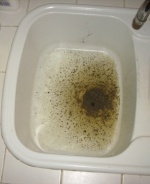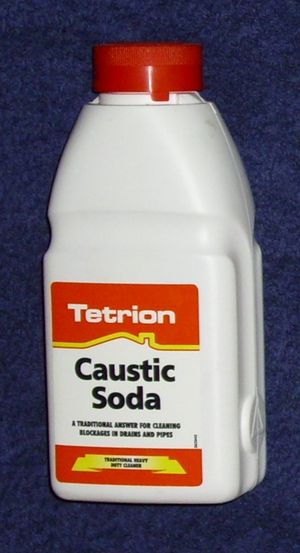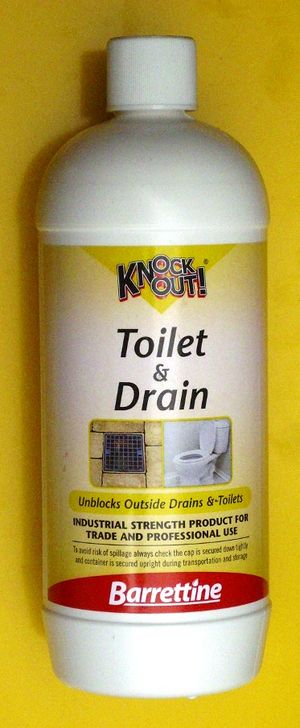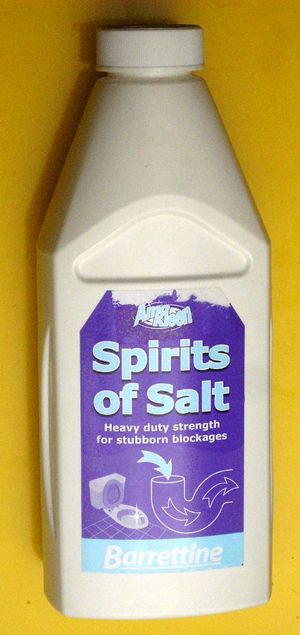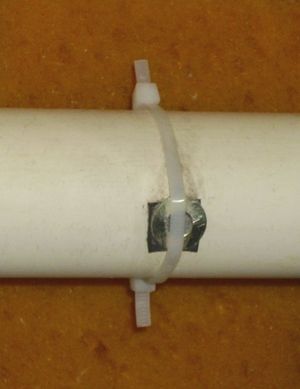Unblock a Drain
There are many ways to unblock drains. Always act before the blockage is total, as a total block makes getting chemicals to the blockage difficult to impractical.
The Blockage
- The most common drain blocking material is fat, which can be cleared by caustic soda, rodding, or physical removal with hand or sticks.
- The next most common blocker is hair and matted fibres, which can be tackled with strong acids, physical removal or sometimes a plunger.
- Soft foods can also block drains sometimes, these can be tackled by scooping out, rodding, use of a wire and sometimes a plunger. If just partially broken up in situ to allow water to pass, the remainder decomposes and clears itself over the weeks ahead.
- Leaves can block open outdoor drains, both at ground level and in elevated hoppers. Best scooped out by hand.
- The least common drain blocker is limescale, which responds to long immersion times with acids, or if accessible and in a strong concrete drain, it can often be chiselled off. A needle drill is also effective on scale, but few DIYers have one.
Blockage by solid items can also occur, most often toilet rim blocks, and sometimes plastic toys. No chemical will dissolve these, they must be removed.
Unblocking
Which to try first?
- Caustic soda
- Rodding
- Sulphuric acid is an option, works well but can do damage
- Lots of boiling water can be tried if none of the above are to hand, it fairly often works.
Sink waste pipes can usually be rodded with a handheld wire unblocker, 2mm iron wire or fish tape.
Heat
Boiling water
Not the most effective, but sometimes unblocks fat blockages. Can be tried if nothing else is to hand. Fat dissolving chemicals should then be used to clear the drain properly. The more boiling water is used, the longer it stays hot and the more chance it has of melting through the blockage.
Chemicals
Caustic soda
Caustic is a good first chemical to use, as it eats the most common blocking materials and doesn't attack the drain itself. It eats fats, which are the most common blocker of kitchen sinks. Boiling caustic is much faster than cold caustic.
Caustic is a high risk chemical. It burns skin and can cause serious eye damage. If you get any at all in your eye, it is important to seek treatment urgently. Delay in treatment (it doesn't hurt) generally results in serious irreversible damage.
Preparing boiling caustic solution sprays strong alkali droplets, and thorough eye protection is essential.
- Caustic soda is a strong alkali.
- Never mix a strong alkali with an acid.
- Eye protection needed
Washing soda and baking soda are much weaker, and usually inadequate.
Sulphuric acid
Sulphuric is usually the 2nd choice unblocking chemical. Its effective, but attacks cement drain joints.
- Eats organic material, eg turd & paper
- Eats limescale
- Very aggressive
- A high risk chemical
- Wear eye protection or a full face shield
- Dont't mix acid with alkali.
- Don't pour water into acid
- Keep strong acids off chromework.
- When using strong acid, its advisable to flush the loo a few times afterwards, in case the sewage piping contains metal or mortared pipework, which acids attack.
Hydrochloric acid
- Eats organic material
- Eats limescale.
- A relatively high risk chemical.
- 30% hydrochloric acid is sold as brick acid. Some patio cleaners contain a lower level of HCl.
- Attacks cement drain joints
- Never mix a strong acid with an alkali
- Never mix acid with bleach
- Don't pour water into acid
- Protect eyes from HCl
- Keep strong acids off chromework
- When using strong acid, its advisable to flush the loo a few times afterwards, in case the sewage piping contains metal or mortared pipework, which acids attack.
Bio-enzymes
These eat biological matter, but can take a very long time to do so. Also unlikely to survive being added to a drain full of caustic or acid. Too slow for drain unblocking.
Mechanical
Rod
The most effective mechanical unblocker. Use when other measures have failed. Drain rods are £15-20 a set in 2012.
Metal tape/wire
A reel of flexible metal strip or tape makes a low cost & physically small rodding device. Also sold in rotating containers for greater effectiveness.
Wire
2mm Iron wire is enough to remove many types of blockage. Cost is minimal, and its already to hand in many cases. An advantage of iron wire is it can be fed in through a 5mm hole, which are easily made anywhere in plastic drain pipe.
Wire does not generally clear a drain fully, but makes a passageway for water. The remainder of the blockage should then be cleared with a suitable chemical.
2mm wire has minimal ability to go round corners, its only good for very short distance rodding.
3mm coathanger wire is much too stiff and behaves badly. 1.6mm wire is much too flexible, and 1mm wire is useless.
Plunger
Block all other airholes, eg overflow. Push plunger down gently but firmly, and pull up with force. Good for sinks where the blockage is an accumulation of small pieces, eg food.
Hose
Insert hose down drain. Block all holes with towel. Turn hose on full blast. Prepare to get wet and make a mess. Works on soft blockages, but messy.
Pressure Washer
Can unblock drains, but very messy, and unblocking sewage creates disgustification and a health hazard. For sewage, full splash protection is desirable, but it won't keep you clean & dry.
Outdoor blockages only.
Curtain Wire
Curtain wire can be used for clearing blockages close to access points. A metal wire/tape tool is better, with much greater reach.
Cleaning points
Plugholes
Some sink/basin plugholes have a built in strainer, sometimes this just needs to be lifted out and cleaned.
Traps
Waste traps fitted under sinks, basins, baths and showers can be disassembled to empty the accumulated crud, and allow rodding access to the pipe. There are a few different styles of trap, but all unscrew by hand, or if stiff with gentle use of a wrench.
Filters
Some washing machines have a cleanable filter at the bottom on the front.
Rodding Access points
Rodding eyes
Drain covers
Open pipe ends
Re-assemblable joints
Compression and some pushfit joints can be disassembled and reassembled. Disassembly is impossible with solvent welded pipe, the parts fuse to make one solid piece of plastic.
Drilled hole
A 5mm hole allows a 2mm iron wire to pass inside the pipe. This is useful for solvent weld pipework with no means of access. A 5mm hole is drilled, and capped after use with either
- a piece of plastic pipe and some pipe weld solvent, or
- a rubber washer, a bent metal washer and a cable tie (pictured)
- a short screw
- piece of plastic, silicone, cable tie

